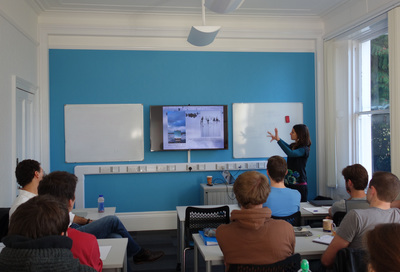|
In the first workshop, WISE engineering students from the Universities of Bristol, Bath, Exeter and Cardiff got together to explore the topic of flooding from different angles in the University of Exeter. The titles of their approaches were the following: “Recent flooding in the Somerset Levels and Moors (2013-14)”, “Societal response to flooding in Somerset”, “The future of flooding in Somerset”, “Historical flooding in Somerset (last 100 years)” and “Overview of the long term flood history of the Somerset Levels”. Each of the groups presented their particular research to the rest by explaining their posters which led to a discussion. They had the theme of flooding in the Somerset Levels and Moors from different periods of time, however, similarities over time and reflexions over the whole took place. After presenting their views on these topics from an engineering perspective, the students were introduced to art projects looking at similar topics with a particular focus on projects with a socially engaged dimension. Firstly, the artist Seila Fernández Arconada introduced her practice with special emphasis on the creative process and how different media could carry similar approaches in her practice. Coming from a multimedia background, the artist, has evolve along the years to collaborative and participatory approaches focusing on environment and climate change. Her presentation was connected to the broader contemporary art in which projects by artists such as Francis Alÿs, Eve Mosher, Pedro Reyes, Olafur Eliasson and Alessandro Rolandi, among others, were explained. In addition, students were involved in some creative activities for them to look at storytelling and visual representation differently. With that purpose they were asked to bring an object to tell a story about their interest in water and share the story with their groups. This showed how by looking at defining a personal relationship with that object we can generate more engaging stories to connect with the “audience”. In addition, a collaborative drawing activity was connected to this and by choosing one of the objects each of the groups draw the different dimensions of the objects by following instructions from the artist. Those simple creative activities were an introduction for them to engage with communication and collaborative process. The last part of the session focused on questions such as: what do you think are the differences between art and engineering? What is an engineer? What does creativity mean in your field of study? What do you mean when you use the term community? Among other to look for cultural backgrounds, stereotypes and perceptions that could influence communication leading to a discussion that took us from the role of engineers and how is perceived by society to community and how this term could be problematic. After being part in the workshop that helped them look at collaboration and art as a tool to express their research and ideas, they were given the task to generate a proposal in groups to tackle their particular research about Somerset Levels and Moors, but this time, incorporating artistic approaches. For more information: http://thelandofthesummerpeople.org/2015/02/09/first-workshop/http://thelandofthesummerpeople.org/2015/02/09/first-workshop/
0 Comments
Leave a Reply. |
|








